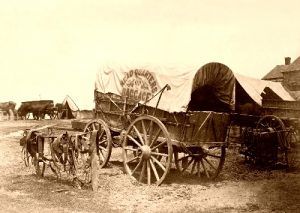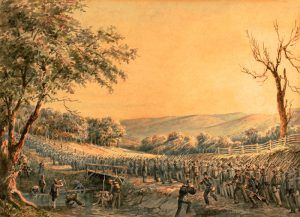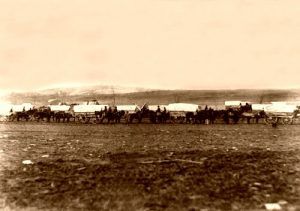By Carlton McCarthy in 1861
The column, which had been moving forward with the steadiness of a mighty river, hesitates, halts, steps back then forward, hesitates again, halts. The colonels talk to the brigadier, the brigadiers talk to the major-general, some officers hurry forward, and others hurry to the rear. Infantry stands to one side of the road while cavalry trots by to the front. Now some old wagons marked “Ord. Dept.” go creaking and rumbling by. With a gay and careless air, one or two light ambulances seem to trip along with the ease of a dancing girl. They and the surgeons seem cheerful. Some, not many, ask, “What is the matter?” Most of the men there know precisely: they are on the edge of battle.
Presently a very quiet, almost sleepy-looking man on horseback says, “Forward, 19th!” and away goes the leading regiment. A little way ahead, the regiment jumps a fence, and — Pop! Bang! whiz! Thud! is all that can be heard until the rebel yell reverberates through the woods. Battle? No! skirmishers advancing. Ordinance Department.
Step into the woods now, and watch these skirmishers. See how cheerfully they go in. How rapidly they load, fire, and reload. They stand six and twelve feet apart, calling each other, laughing, shouting, cheering, but advancing. There: one fellow has dropped his musket like something red hot. His finger is shot away. His friends congratulate him, and he walks sadly away to the rear. Another staggers and falls, with a ball through his neck, mortally wounded. Two comrades raise him to his feet and try to lead him away, but one of them receives a ball in his thigh, which crushes the bone, and he falls, groaning to the ground. They have at last driven the enemy’s skirmishers in upon the line of battle and are waiting. Many men have fallen here; some killed outright, some slightly, some sorely, some mortally wounded.
Now a battery has been hurried into position, the heavy trails have fallen to the ground, and at the command “Commence firing!”, the cannoneers have stepped in briskly and loaded. The first gun blazes at the muzzle, and away goes a shell. The poor fellows in the woods rejoice as it crashes through the trees over their heads and cheer when it explodes over the enemy’s line.
But help is coming. At the edge of the woods, where the skirmishers entered, the brigade is in line. Somebody has ordered, “Load!”
The ramrods glisten and rattle down the barrels of a thousand muskets. “Forward!” is the following command, and the brigade disappears in the woods, the canteens rattling, the bushes crackling, and the officers never ceasing to say, “Close tip, men; close up! guide center!”
The men on that skirmish line have at last found it advisable to lie down at full length on the ground, though it is so wet, and place their heads against the trees in front. They cannot advance, and they cannot retire without, in either case, exposing themselves to almost certain death. They are waiting for the line of battle to come to their relief.
At last, before they see, they hear the line advancing through the pines. The snapping of the twigs, the neighing of horses, and hoarse commands inspire a husky cheer, and when the line of the old brigade breaks through the trees in full view, they fairly yell! Every man jumps to his feet, the brigade presses firmly forward, and soon the roll of musketry tells all who are waiting to hear that serious work is progressing away down in the woods. Brigade after brigade and division after division is hurried into line and pressed forward into action. Battalions of artillery open fire from the crests of many hills, and the battle is begun.
Ammunition trains climb impassable places, cross ditches without bridges, and somehow place themselves within reach of the troops. Ambulances, which an hour before went gaily forward, now slowly and solemnly returned loaded.
Shells and musket balls, which must have lost their way, go flitting about here and there, wounding and killing men who deem themselves far away from danger. The negro cooks turn pale as these unexpected visitors enter the camps at the rear, and the rear is extended at once.
At the front, the enemy’s battery is replying, and shells are bursting overhead or plowing huge furrows in the ground. Musket balls are rapping on the rims of the wheels and sinking with a resounding thud into the bodies of the poor horses. Smoke obscures the scene, but in faint outline, the cannoneers can be seen cheerfully serving the guns.
As the opposing battery ceases firing and having limbered up, scampers away, and the last of the enemy’s infantry slowly sinks into the woods out of sight and out of reach, a wild cheer breaks from the cannoneers, who toss their caps in the air and shout, shake hands and shout again. At the same time, the curtain of smoke is raised by the breeze and borne away.
The cavalry is gone. They have passed through the lines and down the hill with jingle and clatter and are already demanding surrender from many a belated man. There will be no rest for that retreating column. Stuart, with a twinkle in his eye, his lips puckered as if to whistle a merry lay, is on their flanks, in their rear, and their front. The enemy will send their cavalry after him, of course, but he will stay with them, nevertheless.
Add now the streams of wounded men slowly making their way to the rear; the groups of dejected prisoners plodding along under guard, and you have about as much of a battle as one private soldier ever sees.
Compiled and edited by Kathy Weiser-Alexander/Legends of America, updated November 2021.
Notes and Author: This tale was written by Carlton McCarthy and was included as a chapter in Albert Bushnell Hart’s book, The Romance of the Civil War, published in 1896.
Also See:



